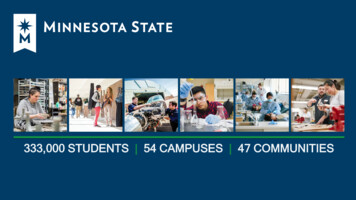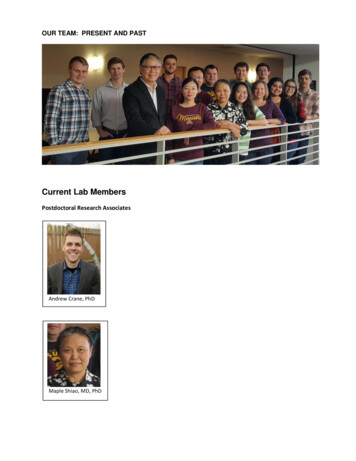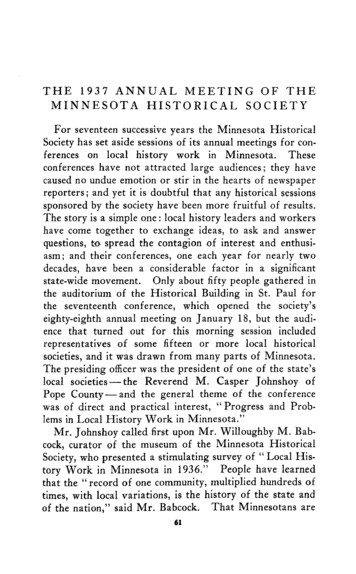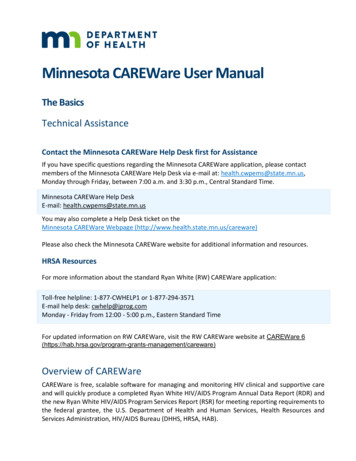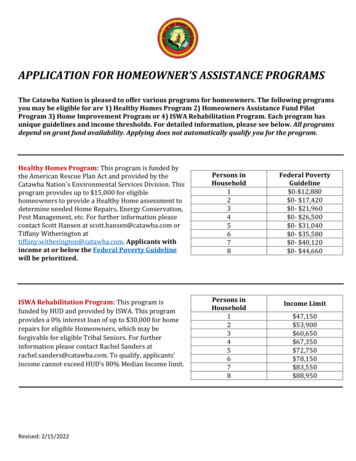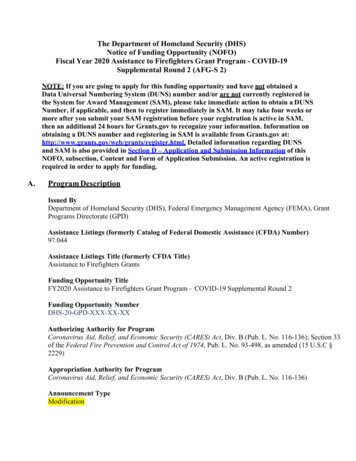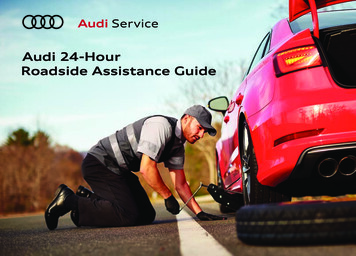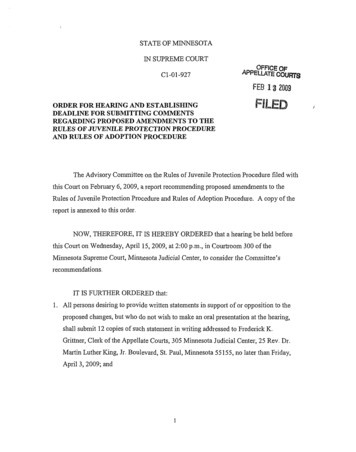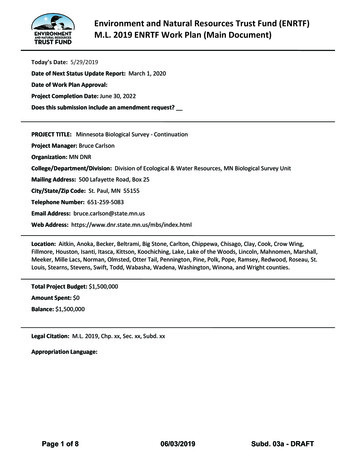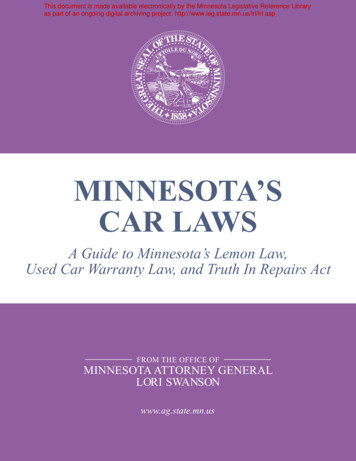
Transcription
mnltap.umn.eduINSIDE:Minnesota Local Technical Assistance ProgramMarch 2022Vol. 30, No. 1Snow and ice control handbook updatedROADS SCHOLARSCongratulations, Class of 2021!. 2HONORSAssociation project-of-year awards. 3LTAP anniversaries. 3WATERCulverts in a changing climate. 5SAFETYWork-zone safety online course. 6Barrel truck for work zones. 6Pedestrians in work zones. 6INFORMATION SERVICESThe Shelf & search tools. 7Workforce outreach toolkit. 7Tips for workforce planning. 7TRAININGMaintenance Training & Demo Day . 8CDL training . 8An updated version of the Minnesota Snow and Ice ControlHandbook for Snowplow Operators is now available onMinnesota LTAP’s website. The handbook promotesunderstanding of the tools, best practices, and limitationsfor snow and ice control. It also helps operators understand when to use and when not to use these tools andpractices.The Minnesota Local Road Research Board (LRRB)Snow continued on page 4Manholes and catch basins:Guidebook helps select materials, methodsMinnesota municipalities and counties use varying practices to construct and repair catch basinsand manholes. They also choose from a variety ofproducts to build a catch basin or manhole, sealstructure joints, and help reduce infiltration andintrusion.There is little documentation, however, on thelocal experience with these structures in Minnesota,as most resources are promotional literature or articles from industry publications. A new guidebookprovides foundational information for municipalengineers about these essential installations.Manholes continued on page 4Pandemic traffic drop-offprompts more speedingand fatal crashesToward the beginning of the COVID-19 pandemic,anecdotal observations found that speeding andhigh-speed crashes were on the rise as driverstook advantage of emptier roads and strainedlaw enforcement. To better inform future decision making, the Minnesota Department ofTransportation (MnDOT) wanted to quantify thisphenomenon.The first stage of the project—run by IowaState University’s Institute for Transportation(InTrans)—was to compare traffic volumes andspeeds across Minnesota before and after March2020, when COVID was first detected in the state.Neal Hawkins, associate director of InTrans anda principal investigator for the project, says thatautomated traffic recorder (ATR) and traffic sensorstations were used for the comparisons. Together,the stations gathered data on factors such as rawvolume, average speed over time, and numberof vehicles at high speed. The researchers chosestations that had complete data spanning March–December 2019 and March–December 2020.Pandemic continued on page 6READ THEEXCHANGEonline for links to publicationsand other resources.Minnesota Local Technical Assistance ProgramCenter for Transportation StudiesUniversity of MinnesotaUniversity Office Plaza, Suite 4402221 University Avenue SEMinneapolis, MN 55414PERMIT NO. 90155TWINCITIES MNPAIDNONPROFIT ORG.U.S. POSTAGE
M I N N E S O TA T E C H N O L O G Y E XC H A N G EROADS SCHOLARSCongratulations, RoadsScholar Class of 2021!Seventeen standouts earned Roads Scholar certificates in 2021. We recognize and thankyou for your hard work!The Roads Scholar Program offers two certificates—one focused on general maintenance operations and one focused on leadership and management. The curriculum isdesigned to provide participants with fundamental training in safety, management, andadvanced technologies, as well as offer exposure to other topics relevant to the transportation field. nMAINTENANCE OPERATIONS AND TECHNICAL CERTIFICATEKevin Bartholomew, City of MahtomediAndy Brennan, City of Mendota HeightsTony Gleason, City of LakevilleCarey Kotilinek, City of BuffaloFrank Krahn, Bennington TownshipJarrett Krensing, City of Mendota HeightsMike Loehrs, City of WatertownJed Rice, Mower CountyMatt Zinniel, Stearns CountyLEADERSHIP, SUPERVISORY, AND OPERATIONSMANAGEMENT CERTIFICATETravis Gossard, City of EdinaJamey Heckles, Carver CountyCarey Kotilinek, City of BuffaloTim Meuleners, Carver CountyNick Nystrom, City of RobbinsdaleBrian Randt, City of MahtomediDavid Stifter, City of ChamplinTroy T. Walsh, League of Minnesota CitiesJosh Yonak, City of Golden ValleyM I N N E S O T A! Yeah, grads!What our grads say:Troy T. Walsh, loss control consultant / public works andpublic safety specialist with the League of Minnesota Cities,completed a Leadership, Supervisory, and OperationsManagement (LSOM) certificate.“I enjoyed the opportunity to build my leadership skillsand develop additional skills to become a better consultant,” Walsh says. “Having additional leadership skills willhelp improve communications, writing of reports, and anunderstanding of local budgeting conversations Always continue to grow andlearn!”Carey Kotilinek, City of Buffalo street and facility superintendent, completedLSOM and Maintenance Operations and Technical (MOT) certificates.“The Road Scholar Program has helped me in my transition from a street/park maintenance person to superintendent,” Kotilinek says. “Having both themaintenance and leadership [certificates] is great for people who want to moveup the ladder. I will continue taking some courses because they are very informative and constantly changing. The small, virtual, two-hour classes are greatto have your crew watch with you, so they can learn as well. I recommend thisprogram for all those that are interested.”Nick Nystrom, utilities operator with the City ofRobbinsdale, completed an LSOM certificate.“What I liked best about the LTAP Roads Scholar Programwas the variety of classes that were part of the program andhow knowledgeable the instructors were,” Nystrom says.“Being able to complete some of the classes in an onlineformat because of the current pandemic was convenientand effective.“Completing the [leadership] certificate has helped me obtain very usefulknowledge and skills that will help prepare me for whatever the future holds forme during my career in the public works field. Listening to each of the instructors talk about their different individual management and leadership styles, Iwas able to learn a variety of ways to lead and manage people. I am looking forward to taking more LTAP classes in the future.”Matt Zinniel, maintenance superintendent for StearnsCounty Public Works, completed an MOT certificate.“I really enjoyed the variety and expertise of the instructors,” Zinniel says. “Always interesting to see differentapproaches to common problems, and see if they can beimplemented to improve your current operations.” nTechnology ExchangeThe Minnesota Local Technical Assistance Program is partof the Federal Highway Administration’s Local TechnicalAssistance Program (LTAP). LTAP is a nationwide effortdesigned to foster and improve information exchangeamong local practitioners and state and national transportation agencies. Minnesota LTAP is administered bythe Center for Transportation Studies at the Universityof Minnesota, and cosponsored by the Minnesota LocalRoad Research Board and the Minnesota Department ofTransportation.The University of Minnesota is committed to the policy thatall persons shall have equal access to its programs, facilities, and employment without regard to race, color, creed,religion, national origin, sex, age, marital status, disability,public assistance status, veteran status, or sexual orientation. This publication is available in alternative formats uponrequest.Any product mentioned within should not be considereda product endorsement. Authors’ opinions/findings do notnecessarily reflect the views of Minnesota LTAP.2March 2022Contact usTechnology Exchange is published quarterly. For free subscriptions, mailing list changes, or extra copies, contact usat the address or phone number below.Technology Exchange welcomes contributions and suggestions from its readers. Submit ideas and other commentsto Pamela Snopl, managing editor.Minnesota LTAPCenter for Transportation StudiesUniversity of MinnesotaUniversity Office Plaza, Suite 4402221 University Avenue SEMinneapolis, MN 55414Phone: 612-626-1077Email: mnltap@umn.eduWeb: mnltap.umn.edu 2022 Minnesota Local Technical Assistance Program(LTAP), University of MinnesotaMinnesota LTAP StaffLTAP Director: Stephanie MalinoffLTAP Program Director: Mindy CarlsonLTAP Program Coordinator: Katherine StanleyLTAP Program Assistant: Samantha RedmondSenior Editor: Pamela SnoplDesigner: Angela KronebuschFreelance Writer: Sophie KochPhoto CreditsShutterstock; MnDOT/LRRB; MCEA; CEAM; APWA; NickBentelspacher and Kyle Weisshahn; Crawford County,Iowa; Marathon County, Wisconsin, Highway DepartmentPrinted on 50% recycled fibers, including minimum 30%postconsumer waste.Minnesota LTAP Steering CommitteeChair: Kristine Elwood, State Aid for Local Transportation Divisionand Statewide Radio Communications Division, MnDOTJoe Campbell, Federal Highway AdministrationJim Foldesi, St. Louis County; Minnesota LRRBTim Kieffer, City of Golden Valley; Minnesota Street SuperintendentsAssociationJeff Krueger, Executive Director, Minnesota Association ofTownshipsJon Lennander, City of Fridley; City Engineers Association ofMinnesotaWill Manchester, City of Minnetonka; LRRB ResearchImplementation CommitteeChris Petree, WSB Minneapolis; American Public WorksAssociation–MN ChapterRich Sanders, Polk County; Minnesota County Engineers AssociationPaul Sandy, City of Brainerd; City Engineers Association ofMinnesotaKyle Shelton, Center for Transportation Studies, U of MRick Shomion, Office of Maintenance, MnDOTKatie Walker, Office of Research and Innovation, MnDOTAndrew Witter, Sherburne County;Minnesota County EngineersAssociation
M I N N E S O TA T E C H N O L O G Y E XC H A N G EHONORSPublic engagement, visionary planning features of top projectsCongratulations to the recipients of 2021 project awards! Please see the association websites for details and a full list of awards and recipients.Minnesota County EngineersAssociationProject of the Year: New South Side CSAH 8 Corridor,Pennington CountyThis project included the construction of two roundabouts, a bridge, trail, connection roadway work,and overlay. The new corridor allows trucks to passaround Thief River Falls, promoting safer and moreefficient commerce movement through the region.Making sure the roundabouts functioned foroversized vehicles was a point of discussion at publicinformational meetings. The county also met severaltimes with a manufactured house dealer to makesure its needs were met.“I’m very proud of the project,” says Mike Flaagan,Pennington county engineer. “It was something thatthe previous engineer, Delton Schultz, had envisioned 25 years ago, but the community just wasn’tready [for] yet. With a strong local economy, whichincludes DigiKey, Arctic Cat, and Sanford Health,Thief River Falls has shown continuous growth andwas the driving force behind the project. The projectwill certainly be an economic benefit not only toThief River Falls but for the region as well.”The Pennington County project included a roundabout and safety improvements near a school.Highway Safety Achievement Award: DakotaCounty TransportationA safety assessment process was undertaken forrural intersections, school-area travel, and pedestriancrossings to evaluate and identify short-term andlong-term actions to improve safety. Project teams,website updates, county meetings, advisory committees, and map-tool outreach were used to shareinformation and develop a comprehensive approach.The assessment process and capital investmentsidentified from this work were incorporated intoDakota County’s 2040 Transportation Plan, adoptedJune 2021.City Engineers Association ofMinnesotawithin an existing brownfield site monitored by theMinnesota Pollution Control AgencySt. Louis Park took a holistic approach to evaluate thedistrict and surrounding areas before construction.Project of the Year: Historic Walker Lake StreetProject, St. Louis ParkAmerican Public Works Association –Minnesota ChapterThe Historic Walker Lake Street and AlleyReconstruction project is the culmination of severalyears of visioning, planning, engagement, design,and construction led by the City of St. Louis Park torevitalize the Historic Walker Lake District. The corecommercial heart of the area remained over theyears, but the infrastructure aged and did not complement the modern multimodal and environmentalneeds of the area.In 2018, the city first led the development ofa revitalization plan for the district, evaluatingpedestrian and bicycle facilities, safety, wayfinding,parking, placemaking, and areas for communityevents. Input was gathered from the surroundingcommunity.Design and construction included full reconstruction of Lake Street, Walker Street, and Library Lane;railroad crossing modifications at two locations; newwater main and storm sewer facilities; and an underground stormwater retention system to mitigatelocalized flooding of businesses in the district—allProject of the Year: Minnehaha Park Area SewerRehabilitation, Metropolitan CouncilThis project was the culmination of over eight yearsof planning, design, and construction. Challengesincluded working up to 75 feet below the groundsurface, maintaining wastewater flows in excess of59,000 gallons-per-minute throughout the construction period, avoiding impacts to a rare groundwaterresource protected by state statute, and workingwith over 12 unique public stakeholder groups in thecenter of an urban area and a high-traffic park. The 20,000,000 project was successfully completed onschedule and within budget. nSteering committee updateMike Flaagan of Pennington County has completed his service on the MnLTAPSteering Committee. He is succeeded by Will Manchester, Minnetonka city engineer,who will also represent the LRRB Research Implementation Committee. We thankthem both for their contributions! nWill ManchesterHappy 30thanniversary to us!According to a Google search, the traditional 30th wedding anniversary gift isthe pearl, which symbolizes somethingprecious that embodies wisdom. Themodern 30th anniversary gift is a diamond, which reflects the strength anddurability of a successful three decades ofmarriage.We’re excited to say that this year isMinnesota LTAP’s 30th anniversary. In ourthree-decade relationship with local agencies and other clients, we’ve listenedto your needs and adapted to changing times and technologies. Our continuedexistence, through multiple administrations and funding bills, reflects our valueand durability. And through the Exchange, we’ve provided helpful news andresources—and, we hope, some pearls of wisdom.Of course, our publications are just one part of our relationship withMinnesota’s transportation workforce. In the next three newsletters, we’ll lookback at highlights from our training programs and more.We look forward to many more years ahead, adapting to new conditions andpriorities and serving our clients cost-effectively. Happy anniversary to us all! n—Pamela Snopl, MnLTAP senior editorThe sewer rehab project used techniques to conveywastewater over Minnehaha Creek.Celebrating 40 years of technical assistance programsDecember 23, 1981, is a historic moment for technical assistance programsnationwide. That day, President Ronald Reagan signed a bill into law that officially established the Rural Technical Assistance Program (RTAP).The purpose of RTAP was to provide technical assistance, training, andproducts to counties within the states. By 1991, under the Intermodal SurfaceTransportation Efficiency Act legislation, the RTAP concept was expandedto include urban areas, and the program was renamed LTAP. In addition, theTribal Technical Assistance Program (TTAP) centers were established. Today,there is an LTAP center in every state and Puerto Rico along with a TTAP centerthat serves the American Indian Tribal Governments. n(Adapted from the winter 2022 NLTAPA newsletter.)Our newsletter has sported different looks through the decades.March 20223
M I N N E S O TA T E C H N O L O G Y E XC H A N G EWATERSnow from page 1sponsored the project. MnLTAP led the work of a technical advisory panel (TAP) and producedthe updated document. The TAP, made up of practitioners and technical experts, workedtogether to incorporate current technology and best practices.The handbook has easy-to-scan sections on what to do before the winter, before the storm,during the storm, and after the storm. It also includes application rate guidelines with chartsand examples plus information about materials and quality control.Practices such as anti-icing, prewetting, and pretreating are emphasized. Environmentalrelated tips are sprinkled throughout the handbook to raise awareness and encourage users toreduce the impacts from snow and ice control operations.“We hope the handbook provides the information needed to adopt these practices and toolsto help reduce environmental impacts when dealing with snow and ice control operations,” saysMindy Carlson, MnLTAP program director and the project’s principal investigator. “We appreciate feedback as you begin using this handbook to address situations in your own areas.”The handbook, along with other snow and ice resources, is posted on the Minnesota LTAPwebsite and is available to download for free. Minnesota LTAP also offers workshops using thehandbook. nLearn more: Minnesota LTAP snow and ice control page: mnltap.umn.edu/topics/snow MnLTAP workshop information: Katherine Stanley, sell0146@umn.eduSome handbook highlights:After the storm Share observations to improve operations and learn fromeach other. Use standardized forms to record and track your work andobservations. Refine your procedures and material use based on observations. Document the weather conditions for each storm event.Review the target level of service for each route and see ifit was met or not.After the season At the end of the season, clean and maintain the truck,tanks, brine-making systems, and pumps according tomanufacturer specifications. Place all winter maintenance piles on an impervious padand cover them. This includes salt and salt/sand mixes.Some fish species are affectedby chloride-impaired water, which isequivalent to about1 TEASPOONOF SALT IN5 GALLONSOF WATER.This graphic from the handbook shows how to fine-tune your program.Manholes from page 1The Minnesota Department of Transportation(MnDOT) and the Minnesota Local Road ResearchBoard (LRRB) initiated this project to document bestpractices for managing the effects of settlement andheave at catch basins and manholes. After feedbackfrom municipalities indicated that settlement andheave were not dominant issues, the study wasbroadened to include more general municipal experiences and best practices.A sealant being applied to a manhole chimney interior4March 2022Key findingsAccording to a survey of Minnesota municipalities,manholes and catch basins are typically constructedfrom three materials: precast reinforced concrete,cast-in-place concrete, and manhole bricks or blocks.All surveyed municipalities used precast concrete,five municipalities used cast-in-place concrete,and six cities used bricks and blocks only at theengineer’s discretion. Generally, wall thickness of 5inches was specified for precast and cast-in-placemanholes and catch basins.The chimney section of the manhole, which connects the cone of the manhole with the pavementsurface, showed the most construction variationamong municipalities. All used manhole adjustmentrings (also called extension rings), which span thedistance between the top of the chimney and thepavement surface and assist with leveling.Municipalities used both precast concrete ringsand engineered polymer rings; 40 percent of respondents favored polymer rings and 21 percent did not.The number of respondents who favored concreterings was nearly equal to those who found concreterings less effective. This variation revealed some preferences were a matter of context and experience.Methods to make manholes watertight variedamong the municipalities, but some products werecommonly used, such as rubber or butyl O-ringgaskets between joints; wrap materials, such as InfiShield Gator Wrap; sealing products such as Cretexinternal joint seals for high groundwater areas; andother barrier wraps.Valuable tool with best standards and products“The final report is a valuable tool, collecting in onedocument all the best standards and products forpreventing and addressing common manhole andNew manhole structure before backfillingcatch basin issues, especially those experienced byMinnesota municipalities faced with frequent freezethaw cycles,” says Steve Bot, city administrator/publicworks director with the City of St. Michael and theproject’s technical liaison. The project was sponsoredby the LRRB. nLearn more: Catch Basins and Manholes: Products, Installation,and Settlement and Heave Mitigation (LRRB, Sept.2021)
M I N N E S O TA T E C H N O L O G Y E XC H A N G EWATERGuidance for fish-friendly culverts in a changing climateDesigning infrastructure to handle the impacts ofclimate change is becoming a priority for transportation agencies. Culverts are one example. Roadstream crossings are critical not only for roadwaysafety and longevity but also for fish and otheraquatic organisms that need to move through astream network.“Maintaining habitat connectivity throughouta stream is important to threatened populations,because isolated populations—where fish can’t passthrough culverts—can be particularly vulnerableto climate change impacts,” says Jessica Kozarek,research associate with the St. Anthony FallsLaboratory (SAFL) at the U of M Twin Cities campus.Overly warm waters, or low water or drought, canmake part of a stream uninhabitable for its local fishpopulations. In such situations, fish are more likelyto survive if they can move and take refuge elsewhere, Kozarek says.A variety of factors, however, can prevent fishfrom passing through a culvert. The barriers mightbe physical, such as steep drops that fish can’t jumpover; fast water with no resting areas; or very shallow water. The barriers can also be behavioral: Lackof light, habitat, or cover can make fish unwilling toenter a culvert. These factors vary from one speciesof fish to another, Kozarek explains, which makesit difficult to create designs that accommodate allspecies.SAFL researchers have been working toward theoverarching goal of improving stream connectivityat road-stream crossings. Research has involved arange of smaller-scale projects with various partners, including several sponsored by the MinnesotaDepartment of Transportation (MnDOT) and theMinnesota Local Road Research Board (LRRB).An ongoing project by Kozarek and fellow SAFLresearch associate William Herb aims to evaluate culvert designs in relation to local stream flow and fishpassage data. The researchers surveyed 50 culvertsacross Minnesota, recording data related to culvertdesign and local stream channel characteristics.They also compiled swimming criteria for fish species in the state.The research team then used computer modelsto estimate stream flows for present and futureclimate conditions and the corresponding watervelocities and depths in the culverts. These modelsgenerally found that climate change will hit differently across the state, Herb says. Summer low flows,MnLTAP culvert design training now onlineMinnesota LTAP’s Culvert Design for Stream Connectivity and Aquatic OrganismPassage training, originally offered as six virtual workshops in 2020–2021, is nowavailable for free as a self-paced online course.The course is designed to assist culvert designers in efficiently and consistentlydeveloping public waters culvert projects to address fish passage requirements while designing foraquatic organism passage and stream connectivity. The training uses and expands on content from the2019 Minnesota Guide for Stream Connectivity and Aquatic Organism Passage Through Culverts. This training is sponsored by MnDOT and facilitated by Minnesota LTAP. nLearn more: Culvert Design for Stream Connectivity and Aquatic Organism Passage (online /culvertwhich can create depth barriers in culverts, stand aparticularly high risk of changing in the future.The study supports the current consensus forculvert design practices that recommend mimickingthe structure of the natural streambed and maintaining continuity of sediment transport and debrispassage, Kozarek says. Using this approach, a culvertshould match or exceed the channel width, considerchannel alignment and slope, and provide similarwater depth and velocity as the natural channel.It should also be embedded in the streambed andinclude sediment to mimic the natural roughness ofthe channel.“You eliminate the need to evaluate culvertvelocities and the specific swimming abilities of individual fish species and life stages,” Kozarek says. “Ifthe fish can swim through the channel itself, [they]can likely move through the culvert as well.”These more connective culvert designs are typically larger and therefore involve a higher up-frontcost, Kozarek notes. However, the research has alsofound a parallel between ecological connectivityand flood resiliency, since these culverts can morereadily handle both high and low flows.“Culvert designs that can adapt are more resilientto future climate scenarios,” Kozarek says.The U researchers have developed resources forculvert designers, including the Minnesota Guide forStream Connectivity and Aquatic Organism PassageThrough Culverts, an outcome of research funded byMnDOT and the LRRB.Researchers developed virtual training basedon the guide and held six sessions in 2020–2021through the Minnesota Local Technical AssistanceProgram (MnLTAP). The training is now a free onlinecourse offered by MnLTAP. n—Sophie Koch, MnLTAP freelancerLearn more: CTS webinar: Reducing Climate Change Impactsin Minnesota: cts.umn.edu/events/seminars/2021/climate Minnesota Guide for Stream Connectivity andAquatic Organism Passage Through Culverts (MnDOT/LRRB, 2019)Excavator extension prevents bridge erosionRiprap is material placed beneath bridges near abutments or piers to protectagainst scour and erosion. It can greatly improve structural safety but can bevery difficult to install due to clearance and slope issues. Benching a slope canbe both time-consuming and disturbing to stable vegetated areas.The bridge crew in Crawford County, Iowa, developed a highly effectivedevice for placing riprap under a bridge using equipment situated on the topor deck portion of the structure. For less than 500, they were able to repurposea used section of heavy boilerplate pipe to fabricate an extension that fit thebucket of an excavator. The extension has become a particularly useful tool afterflood events.The project received a 2021 Mousetrap Innovative Project honorable mentionfrom the FHWA Center for Local Aid Support. n(Reprinted from the 2021 FHWA Build a Better Mousetrap booklet.)Learn more: Paul Assman, Crawford County, 712-263-2449, passman@crawfordcounty.orgSubmit your ideas for the 2022 Mousetrapcompetition!We want to hear about your agency's creative solutions! Submissionsare welcome at any time. To enter, just submit an entry form by May 15,2022. You're also encouraged (but not required) to submit photos andshort video clips. Visit mnltap.umn.edu/research/mousetrap or contactKatherine Stanley at sell0146@umn.edu or 612-626-1023. nMarch 20225
M I N N E S O TA T E C H N O L O G Y E XC H A N G ESAFETYBarrel truck protects crews in high-traffic work zonesNew ‘Work-Zone Safety Orientation’ onlinecourse replaces tutorialMinnesota LTAP has revamped our Work-Zone Safety Tutorial into a five-moduleonline course with new content and a more visual format. The free course offersa convenient opportunity for beginning, seasonal, and temporary construction,maintenance, and utility staff to learn about the fundamentals of work-zonesafety before arriving at the job site.The new course uses videos to help learners understand and relate to thecontent. The five modules are divided by road type: Introduction to work-zone safety (for all workers) Low-speed, low-volume streets Low-speed, high-volume streets High-speed, low-volume highways High-speed, high-volume highwaysThe course addresses many of the hazards inherent in road and street workand outlines how these dangers can be minimized to keep motorists, pedestrians, and employees safe. Students are eligible for 0.5 Roads Scholar ProgramMaintenance Certificate credit.SRF Consulting Group, Inc. developed and compiled the course curriculum.Safety Signs of Minnesota, Inc. provided a traffic control vehicle, a traffic control technician, and related equipment. A technical advisory panel of expertsincluded representatives from MnDOT. nIn Wisconsin, county highway departments maintain county and state roadsystems, including interstates. Highway staff often must set up and removetemporary traffic controls on high-speed, multilane roads where the risk ofserious injury—or worse—is greatly elevated.Marathon County wanted to prioritize worker safety while still beingable to remove drums from highway work zones efficiently. Staff used a barrel truck to reduce worker exposure to live traffic while lowering costs bydecreasing crew size. While the truck drives slowly in reverse from the endof the work zone to the beginning, a mounted retrieval arm steers the barrels toward the back of the truck, where a mechanism lifts and loads themautomatically.With an old sign truck chassis as its base, the barrel truck was developedand built entirely in-house by one lead mechanic in approximately 110 hoursat a total cost of 17,000. It has been used a
State University's Institute for Transportation (InTrans)—was to compare traffic volumes and speeds across Minnesota before and after March 2020, when COVID was first detected in the state. Neal Hawkins, associate director of InTrans and a principal investigator for the project, says that automated traffic recorder (ATR) and traffic sensor

